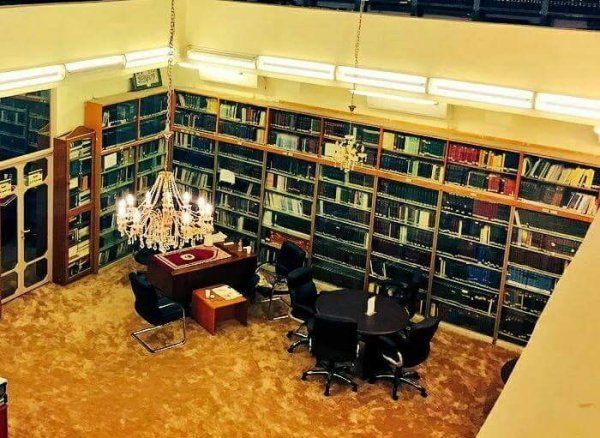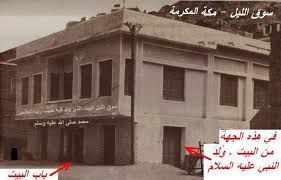
It is considered highly disrespectful for people too walk over the spot where the Prophet saw was born, yet the ews allow this.
The exact spot where the birth of the Prophet saw took place is located on the north-east side of the library site, and is distinguished by a covering of marble which has been fixed over the area . Access to this part of the site is prohibited to the public.
https://muhammadencyclopedia.com/article/en/birthplace-of-prophet-muhammad#foot-30
The Exact Location where Prophet Muhammad saw was laid after Birth
Determining the exact place or room in which the Holy Prophet was born is difficult, but some scholars of Hadith and history have mentioned it. Shaikh Muhammad ibn Ahmed states:
The sacred area in the birthplace of the Holy Prophet , which became famous (when it was known that) he prostrated here (after his sacred birth) is as bright as (a lightened) oven. ft 32
ft: 32: Shaikh Muhammad ibn Ahmed Al-Maliki Al-Makki (2004), Tahseel Al-Maram fe Akhbar Al-Bait Al-Haram wal Mashair Al-Azzam, Maktaba Al-Asadi, Makkah, Saudi Arabia, Vol. 1, Pg. 537.
Ibn Jubair has mentioned some details which elucidate the meaning of ‘as bright as a (lightened oven)’ as recorded by Shaikh Muhammad ibn Ahmed. He states:
… The sacred place where the blessed moment of the joyous birth occurred, ordained by Allah as a mercy to the entire nation, is adorned with silver. ft: 33
ft:33 Muhammad ibn Ahmed Jubair Al-Undlasi (N.D.), Rahlat ibn Jubair, Dar wa Maktabah Al-Hilal, Beirut, Lebanon, Pg. 82.
The aforementioned references clarify that the birthplace of the Holy Prophet is known and narrated through authentic sources. The exact location was marked and people used to visit it, but later on, when the Ottoman Caliphate was destroyed, many historical monuments and artefacts were destroyed by the local government, so it is possible that the exact details mentioned above (regarding the place where the blessed body of Prophet Muhammad was laid after birth) cannot be located, but in the light of the evidence presented above, it becomes clear that it was marked.
This claim has been staunchly made because the narrations have been provided by a group of authors who are reliable, and most of them are scholars, jurists, hadith transmitters, and judges of Makkah; and their reports about the birthplace of the Holy Prophet are authentic and reliable. 34 However, more details are available in these books: Al-Aistieab fe Asma Al-Ashab, 35 Al-Raud Al-Unf, 36 Imta Al-Asma, 37 Salnama Al-Arabia, 38 and Mualim Makka Al-Tarikhiyah wal Atharia. 39
ft34: Abu Sulaiman Abd Al-Wahab Ibrahim (2012), Maktabah Makkah Al-Mukarramah Qadeeman wa Hadithan, Maktabah Al-Malik Fahad Al-Wataniyah, Riyadh, Saudi Arabia, Pg. 50-51.
ft35: Abu Umar Yusuf ibn Abdullah ibn Abd Al-Barr (1939), Al-Istiyab fe Asma Al-Ashab, Al-Maktabah Al-Tujjariah, Beirut, Lebanon, Vol. 1, Pg. 13.
ft36: Abd Al-Rahman ibn Abdullah Suhaili (1941), Al-Raudh Al-Unf fe-Sharha Al-Seerat Al-Nabawiyah, Matb’a Al-Jamaliyah, Cairo, Egypt, Pg. 107.
ft37: Ahmed ibn Ali Al-Muqreezi (1972), Imta Al-Asma bima li Nabi min Al-Amwal wa Al-Hafadah wa Al-Mata, Lejannah Al-Taleef wa Al-Tarjuma wa Al-Nashr, Cairo, Egypt, Vol. 1, Pg. 408.
ft38: Ahmed Zaini Dahlan (1885), Sa’lnama Al-Arabiyah Al-Mathura fe Shan Al-Duwal Al-Uthmaniyah, Matb’a Al-Mairiyah, Makkah, Saudi Arabia, Pg. Pg. 148.
ft39: Shaikh A’tiq ibn Ghaith Al-Biladi (1983), Mualim Makkah Al-Tarikhiyah wa Al-Athariyah, Dar Makkah lil Nashr wal Tawzi, Makkah, Saudi Arabia, Pg. 69.
https://muhammadencyclopedia.com/article/en/first-demolition-and-re-construction-of-the-birthplace-of-prophet-muhammad
When the Ottoman Turks retook the province of Hejaz, they reconstructed the building of Mawlid. This account has been narrated by a renowned European tourist known as J. L. Burckhardt who visited Makkah in 1814 A.D. He wrote the following about the birthplace of the Holy Prophet :
Mouled el Neby, the birth-place of Mohammed (), in the quarter named from it. In the time of Fasy a mosque stood near it, called Mesdjed el Mokhtaba. During my stay, workmen were busily employed in reconstructing the building over the Mouled upon its former plan. It consists of a rotunda, the floor of which is about twenty-five feet below the level of the street, with a staircase leading down to it. A small hole is shown in the floor, in which Mohammed’s () Mother sat when she was delivered of him. This is said to have been the house of Abdullah (), Mohammed’s () father. 1
ft1: John Lewis Burckhardt (1829), Travels in Arabia, The Association of Promoting the Discovery of the Interior of Africa, London, U.K., Vol. 1, Pg. 312-313.
The tourists who visited Makkah for pilgrimage have written about the condition of the birthplace of the Holy Prophet in their travelogues which indicate that the Holy Prophet's birthplace was rebuilt in its former shape after its demolition. Muhammad Labeeb states:
It (birthplace of the Holy Prophet ) is a place elevated about one and a half meters above the road, accessed by stone steps leading to a door that opens to the north. This door leads to a courtyard approximately twelve meters long and six meters wide. In the right (western) wall, there is a door that leads to a dome, in the center of which (leaning towards the western wall) there is a wooden enclosure. Inside this enclosure, there is a marble piece hollowed out to mark the birthplace of Prophet Muhammad . This dome and the adjacent courtyard have a combined area of no more than eighty square meters, and they constitute the house where the Holy Prophet , was born. ft2
ft2: Muhammad Labeeb Al-Batnuni (1329 A.H.), Al-Rihlat Al-Hijaziyah, Matb’a Al-Jamaliyah, Cairo, Egypt, Pg. 52.
Ali Shabbir adds that in the middle of this dome is the place which is considered as the birthplace of the Holy Prophet. At that place, a small frame is erected on which a smaller dome is built. This dome is covered by a green cover, which is embellished with the following verse in golden ink: 3
Surely, a (Glorious) Messenger from amongst yourselves has come to you. Your suffering and distress (becomes) grievously heavy on him (blessings and peace be upon him). (O mankind,) he is ardently desirous of your (betterment and guidance. And) he is most (deeply) clement and merciful to the believers. ft4
ft3: Ali Shabbir (1930), Tareekh Maulid Al-Nabi, Deccan Law Report, Deccan, India, Pg. 22-23.
ft4: Holy Quran, At-Taubah (The Repentance) 9: 128
after above paragraph:
The birth place of the Holy Prophet was wrapped in a green cover in a certain way so that the exact locus of Prophet Muhammad's birth could be indicated.

